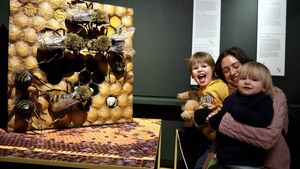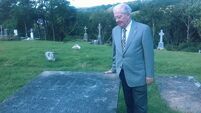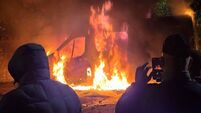Everyone should take a trip to the Murmur of Bees exhibition

Pictured at the National Museum of Country Life in Turlough for the opening of the new exhibition, 'The Murmur of Bees', were Aoife Lawless with Mich (aged 2) and Cian (aged 4). Picture Jason Clarke
I first heard the hum of this story about ten years ago, on the radio programme on RTÉ Radio One. From time to time, the presenters on the programme would talk about bees – and it wasn’t a happy tale. Something was wrong, and bees were dying. At the time, nobody seemed to know exactly why. That was a decade ago before the issue of biodiversity became much more mainstream.
It wasn’t an issue discussed just on that radio programme. Beekeepers knew there was a problem long before the rest of us. In my experience of a few of them, it was no wonder they did. Beekeepers are a rare species, combining as they do a thick skin and a sensitive disposition. They know how to manage the hive, and they know what gets those buzzy little fellows hot. Most importantly, they know that beekeeping is not just about producing honey, but is about understanding how delicate are the threads that hold the natural world together. You have time to observe these things when the swarm is about you.
But of course, biodiversity more generally and the life of bees more specifically isn’t just an issue for beekeepers. It matters to all of us and in a very direct way. We are learning more and more about it every day – but we are still playing catch up. We now live in a world where temperatures are rising and where more and more species are threatened or dying out altogether. This is getting serious. The hottest January the world has known was noted last week.
Temperature records for January in Belmullet – as reported in this newspaper last week – are just the local confirmation of the global trend. Anyone who knows anything about the actual science of all these things has been telling us all this for a long time. But we have reached a point now where we don’t need the scientists to confirm it, and not just because of balmy January days in Belmullet. Listen to those who grow things about what is happening to the soil. Listen to those who get into the waters around our coast and can detect the change in water temperature.
Surely this is all now beginning to add up? The world we have built and the way we live in it is damaging us, and we have to make big changes before it is too late. You cannot be awake and ignore that anymore: you don’t need a sting to alert you to the danger, but far too many of us need some kind of sharp reminder that things have to change.
Want to change the way people drive their cars into an overcrowded Dublin city centre? Oh no, is the cry! It is the end of the world! Want to suggest that maybe we should go a little easy on all the slurry pumped into our rivers and lakes? How dare you! We have been pumping slurry into our waters for generations! It is part of who we are! Perhaps suggest that there may be some connection between pesticides and insect – and bee – declines? Oh no… surely not? How could spraying everything with artificial chemicals have anything to do with that? Or with food losing nutritional value? Or with rates of asthma or with the torrent of allergies we are increasingly experiencing? What possible connection could there be?
Suggest to people that they should recycle their bottles in a new and absolutely sensible way and it is like the weight of all the recycled tonnage has landed on people themselves.
Accepting there is a problem (and even now not all do) is not enough. Nor is it enough to blame the corporations and the politicians and the whoever but me brigade. It is absolutely true that both business and politicians need their feet held to the fire on this, and mega-corporations and their spokespersons making big money need to pay more and be taxed more to fix it – and that includes Ryanair. But as an individual, you cannot live in the Western world, a world of cheap flights and comfortable carbon-burning fuelled lifestyles, and say ‘nothing to do with me, Guvnor’.
Now it is true that if you listen to the debates – frenzied and divisive as they so often are – you can feel a bit of despair. Or even of helplessness. One of the things many parents of late teenagers and young adults will tell you is that their kids wonder if we haven’t already gone too far to fix the damage. That is a depressing thought – and probably, hopefully, wrong – but it is something we should be listening to. It should stir us to act, but you have to fear it might not.
Because having a policy debate on these things is increasingly reduced to wild-eyed people shouting at each other on social media, it is becoming increasingly useful to highlight the issues in other ways. This is why it is really welcome news that the Museum of Country Life in Turlough has opened a new exhibition about bees. Called , it is described as "a journey into the fascinating world of Irish bees". It opened last week and it will run over the next 12 months.
The exhibition will help us understand some more about the role played by bees in the natural cycle. It will examine the vital role bees have played in Irish life over the centuries. Visiting it you will learn about beekeeping and the process of making honey. You will learn about the 100 different bee species identified in Ireland, and which one actually makes the honey.
St Gobnait, the patron saint of bees, is also referenced, through an illustration by the artist Harry Clarke. UCD’s National Folklore Collection is drawn upon to present a wide range of material from our oral tradition showing that bees were a part of Irish life going back in history. There is a wide range of written and visual material about the beekeeping tradition in Ireland, including the first book to be published about it here from 1733. There is even a Lego beehive built during the Covid-19 pandemic.
All these things are pulled together to allow us to reflect on what is important. Before we start arguing about remedies and blowing smoke at each other, it might be a good idea to retreat to a quiet place – a place Yeats called a ‘bee-loud glade’ – and just think for a while about what really matters to our world and its future. After that, we can resume our debates – perhaps like the beekeeper, with a thicker skin and a more sensitive disposition – about what we should be doing to try and save it.






